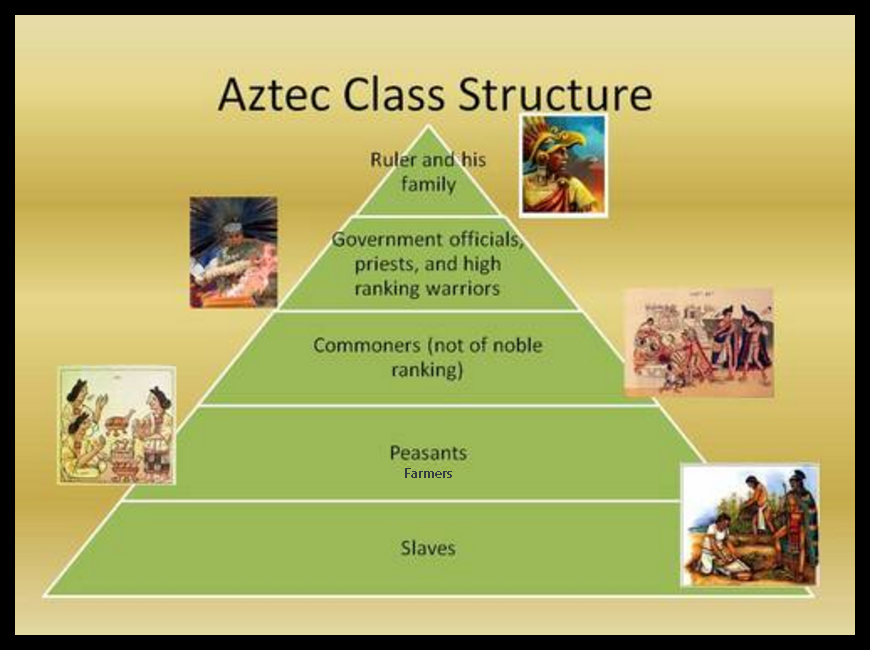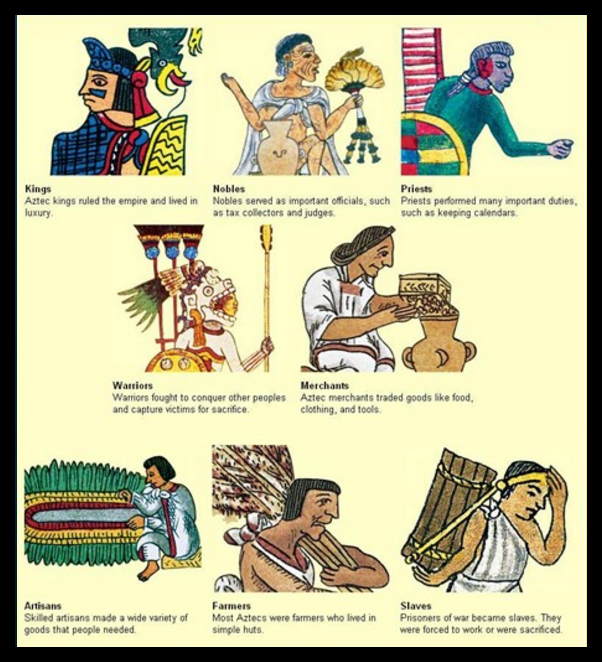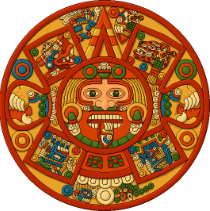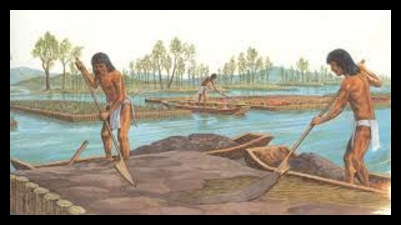AZTEC CIVILIZATIONS
Unit Overview
In this unit, you are going to learn that early Aztec Indian civilizations existed in the Western Hemisphere prior to the arrival of Europeans. These civilizations had developed unique governments, social structures, religions, technologies, and agricultural practices and products.
Complete the Aztec column of the Ancient Civilizations Graphic Organizer while you read and learn below!
Aztec
First the Toltecs, and later the Aztec civilization came to dominate Mesoamerica. They built complex cities with huge pyramids, large apartment houses, and highly decorated palaces. Aztec art and writing have survived to tell the story of their civilization. Aztec warriors spread their power throughout Mesoamerica. The first Aztecs were farmers from northern Mexico. Around the 1100s they migrated south. When they arrived in central Mexico, they found that other tribes had taken all the good farmland. All that was left for the Aztecs was a swampy island in the middle of Lake Texcoco. To survive, the Aztecs hired themselves out as skilled fighters.
The Aztec Empire was made up of city-states. At the center of each city-state was a large city that ruled the area. For the most part, the Aztec Emperor did not interfere with the ruling of the city-states. What he required was that each city-state pay him a tribute. As long as the tribute was paid, the city-state remained somewhat independent of Aztec rule.
Government
The Aztec government was similar to a monarchy where an Emperor or King was the primary ruler. They called their ruler the Huey Tlatoani. The Huey Tlatoani was the ultimate power in the land. They felt that he was appointed by the gods and had the divine right to rule. He decided when to go to war and what tribute the lands he ruled would pay the Aztecs. When an emperor died, the new emperor was chosen by a group of high ranking nobles. Usually the new emperor was a relative of the previous emperor, but it was not always his son. Sometimes they chose a brother who they felt would be a good leader. When a new emperor came into power he had to spend four days fasting, meditating, and worshipping the gods.
The second in command of the Aztec government was the Cihuacoatl. The Cihuacoatl was in charge of running the government on a day to day basis. He had thousands of officials and civil servants who worked under him and kept the government and the empire running smoothly. There was also the Council of Four. These were powerful men and generals of the army who were first in line to become the next emperor. They gave advice to the emperor, and it was important that he had their agreement in major decisions. Other important officials in the government included the priests who oversaw the religious aspects of the city, the judges who ran the court system, and the military leaders.
The Aztecs had a fairly sophisticated code of law. There were numerous laws including laws against stealing, murder, drunkenness, and property damage. A system of courts and judges determined guilt and punishments. They had different levels of courts all the way up to a supreme court. Citizens could appeal rulings to a higher court if they did not agree with the judge. One interesting part of the law was the "one time forgiveness law." Under this law, a citizen could confess a crime to a priest and they would be forgiven. This only worked if they confessed the crime prior to being caught. It also could only be used once. The punishments for breaking a law were severe, with death being a common punishment. Other punishments included having your head shaved or being sold into slavery.
Social Structure
The basic unit of Aztec society was the family. The family was very important to the Aztecs, and marriage was considered sacred. Men could marry more than one wife, but there was usually a primary wife who was in charge of the household. Marriages were arranged by matchmakers.
Families belonged to a larger group called the calpulli. Families and individuals did not own land in Aztec society, the calpulli did. A calpulli was like a clan or small tribe. Many of the families in a calpulli were related to each other. Calpullis had a chief, a local school, and often had a trade in which they specialized.
Above the calpulli was the city-state, also called the Altepetl. The city-state included a large city and its surrounding areas. The largest city-state and capital of the Aztec Empire was Tenochtitlan. Other city-states in the Aztec Empire had to pay tribute to the emperor who lived in Tenochtitlan.

There were different social classes within Aztec society. At the very top of society was the king along with his family. The king was called the Huey Tlatcani, and he was very powerful.
-
Tecuhtli - Just below the emperor, who ruled the capital Tenochtitlan, were the rulers of the other city-states. They were very wealthy and lived in large palaces within their cities. They had complete power over their cities as long as they paid tribute to the emperor.
-
Pipiltin - Below the Tecuhtli were the pipiltin or the noble class. Only the noble class could wear certain types of clothes and jewelry such as feathers and gold. The pipiltin held the high ranking positions in the priesthood, the army, and the government. They formed the city council which helped to rule the city-states. The king was always chosen from the pipiltin.
-
Pochteca - There was a special class of Aztec merchants called pochteca. They were treated like the nobility in society because their jobs were considered very important to the Aztec Empire. The pochteca traveled long distances in order to bring back luxury goods that were treasured by the nobility.
-
Macehualtin - The common people in Aztec society were called the macehualtin. This included the farmers, warriors, and craftsmen. Later on in the history of the Aztecs, craftsmen and warriors began to have a higher position in society than the farmers.
-
Slaves - At the bottom of Aztec society were the slaves. In Aztec society, the children of slaves were not slaves. Aztec people became slaves by selling themselves into slavery to pay for debts or as punishment for crimes. The slaves had certain rights. They were not to be mistreated by their owners, they could buy their freedom, and they could not be sold by their masters unless they agreed.

Religions
The Aztec Empire had a polytheistic religion. The Aztecs worshiped many gods. When they took over a new tribe or culture, they often adopted the new tribe's gods into the Aztec religion. It was a combination of ancient and contemporary religious traditions and was shaped by a belief in the struggle of forces of "good" versus "evil."

One of the most important aspects of Aztec religion was the sun. The Aztecs called themselves the "People of the Sun." They felt that in order for the sun to rise each day the Aztecs needed to perform rituals and sacrifices to give the sun strength. Despite worshipping many gods, there were certain gods that the Aztecs considered more important and powerful than the others.
The most important god to the Aztecs was Huitzilopochtli. The most fearsome and powerful of the Aztec gods, Huitzilopochtli was the god of war, the sun, and sacrifice. He was also the patron god of the Aztec capital city of Tenochtitlan. The Great Temple in the center of the city was built in honor of Huitzilopochtli and Tlaloc. His name is thought to mean "left-handed hummingbird." He was often drawn with feathers and holding a scepter made from a snake.
The Priests were responsible for making sure that the gods were offered the correct offerings and sacrifices. The Aztecs often went to war in order to take captives that they could use in their sacrifices. They had to perform all sorts of ceremonies in the temples to make sure that the gods were not angry with the Aztecs. Priests had to undergo extensive training. They were well-respected and powerful in the Aztec society.
The Aztecs believed that the sun needed the blood of human sacrifice in order to rise each day. They performed thousands of human sacrifices. Some historians think that more than 20,000 people were killed when the Great Temple was first dedicated in 1487. The Aztecs believed in a number of levels of heaven and the underworld. How you died determined where you went. Those who died in battle would go to the top level of heaven. Those who drowned would go to the underworld.
The Aztec calendar played an important role in their religion. They held a number of religious ceremonies and festivals throughout the year. The largest of the Aztec festivals was the Xiuhmolpilli, which meant "new fire." It was held once every 52 years in order to prevent the world coming to an end.
Technology
One of the innovations the Aztecs had before much of the rest of the world was mandatory education for all. Everyone, boys and girls, rich and poor, were required by law to attend school.
One of the most famous aspects of Aztec technology was their use of calendars. The Aztecs used two calendars. One calendar was used for tracking religious ceremonies and festivals. This calendar was called the tonalpohualli which means "day count." It was sacred to the Aztecs and was very important as it divided time equally among the various gods and kept the universe in balance. The other calendar was used to track time. This calendar was called the xiuhpohualli or "solar year."
A major part of Aztec culture was bathing at least once per day. They needed fresh water in the city to do this. At the capital city of Tenochtitlan the Aztecs built two large aqueducts that carried fresh water from springs located over two and a half miles away.
The Aztecs believed that illness could come from natural causes as well as supernatural causes (the gods). They used a wide variety of herbs to cure sickness. One of the main cures doctors suggested was steam baths. They thought that by sweating, the poisons making the person sick would leave their body.
Agriculture
The Aztecs used agriculture to grow food such as maize, beans, and squash. One innovative technique they used in swampy areas was called the chinampa. A chinampa was an artificial island that the Aztecs built up in the lake. They built many chinampas and used these manmade islands to plant crops. The chinampas worked well for crops because the soil was fertile and the crops had plenty of water to grow. The chinampa farms were often called "floating gardens" as they appeared to float on top of the lake. They were built in rectangles and the farmers would travel between the fields in canoes.

 |
| Unit 11 Aztec Civilization Activity |
| Unit 11 Aztec Article and Quiz |
Now answer the questions!